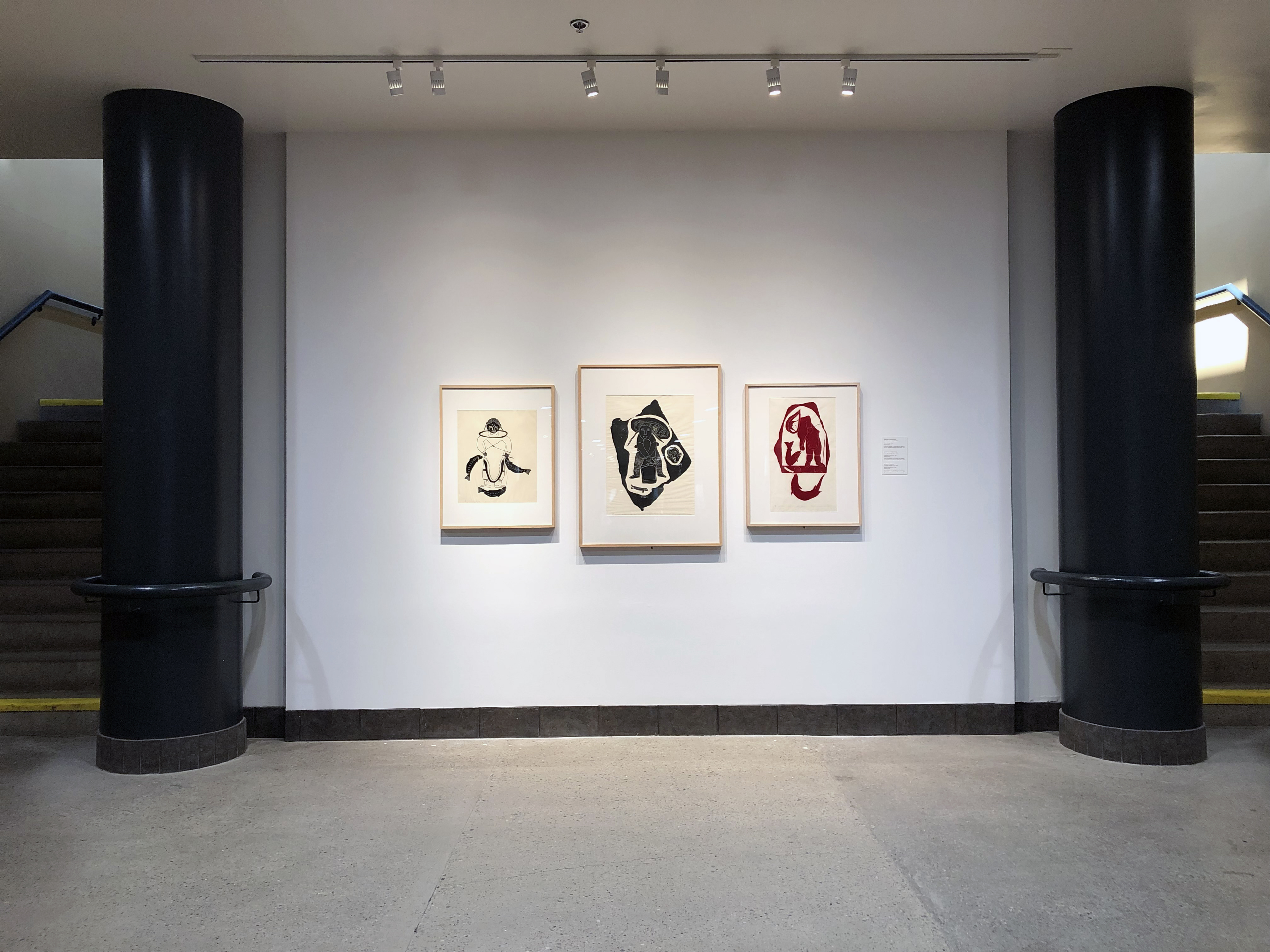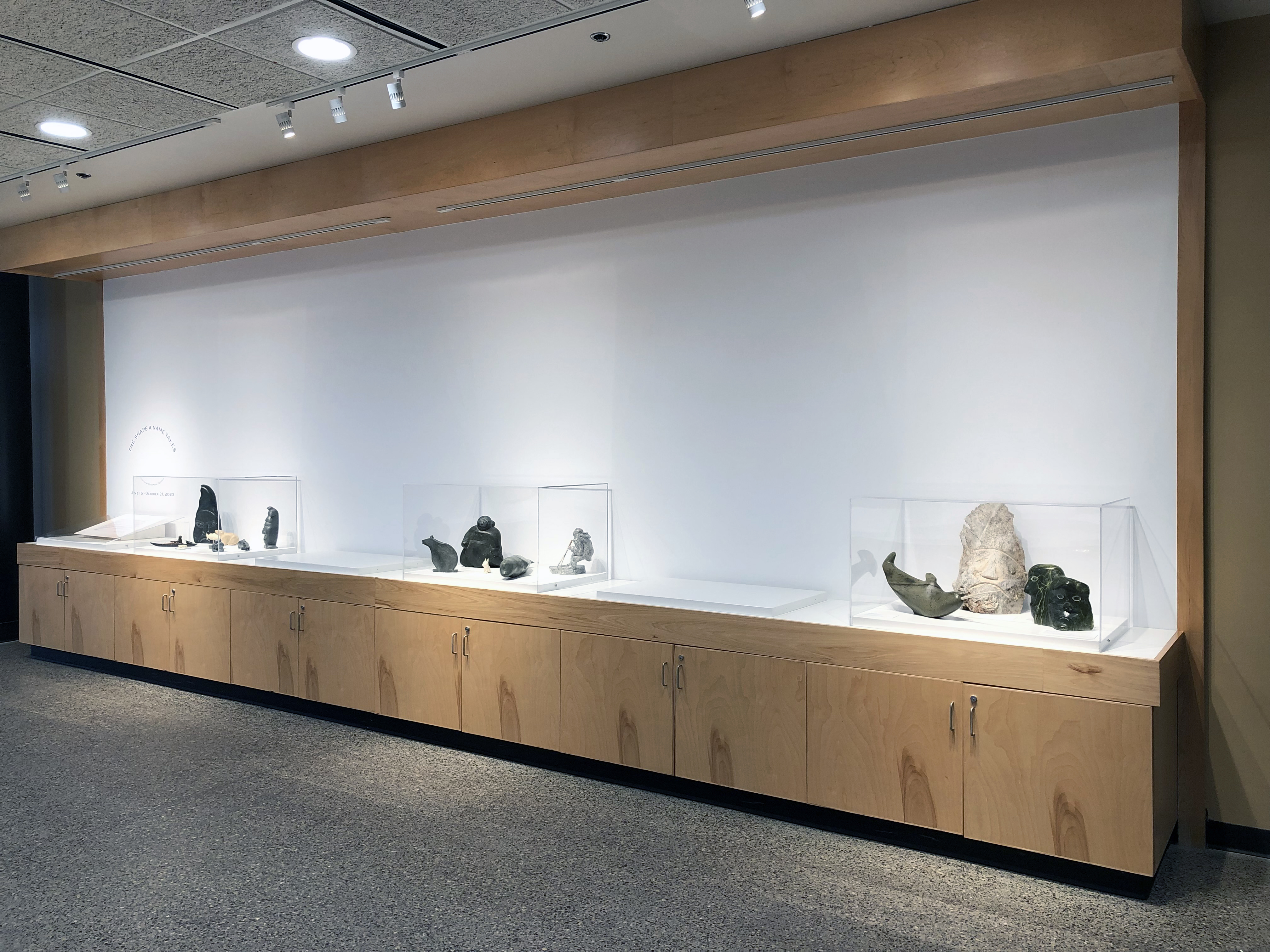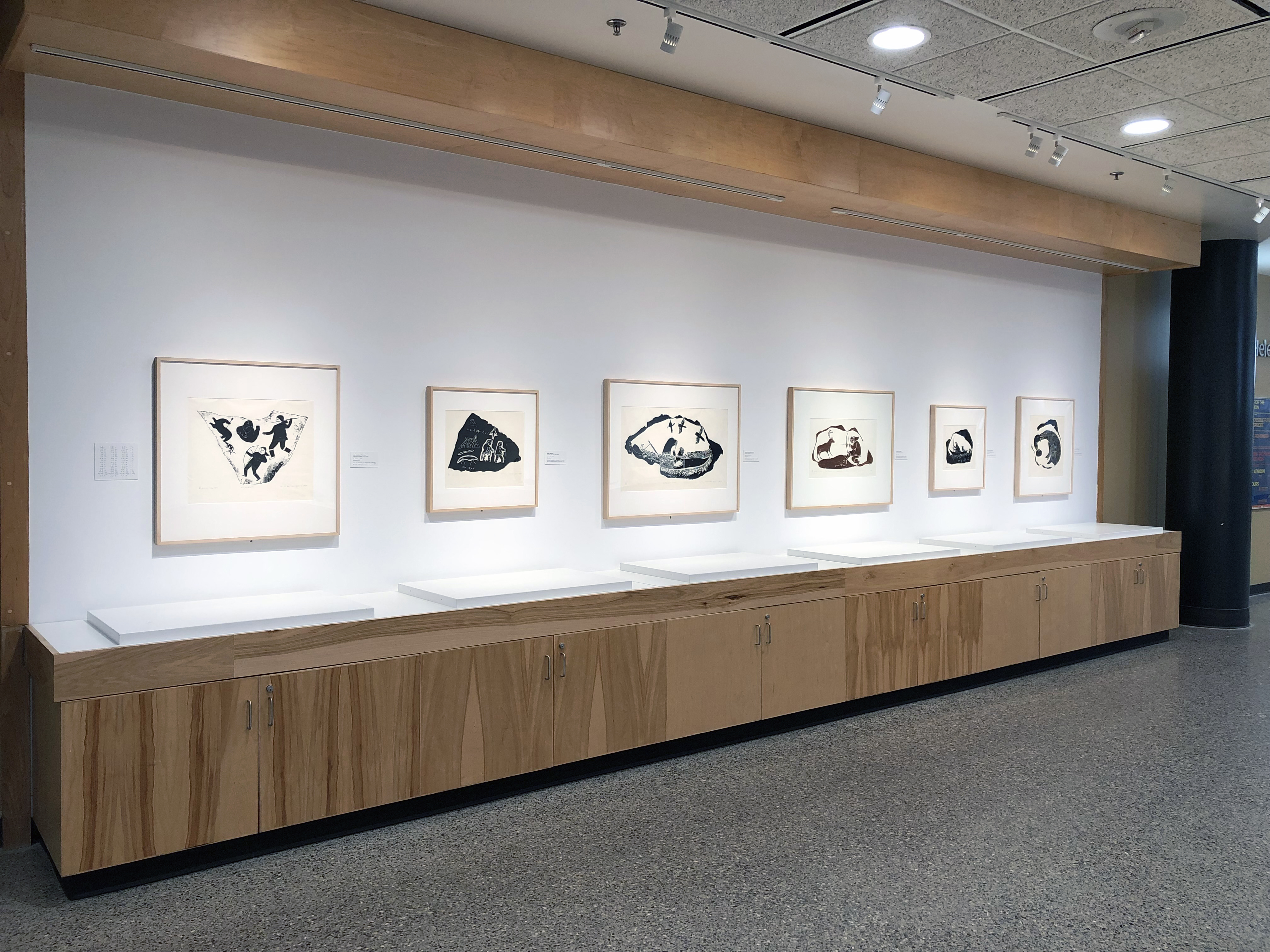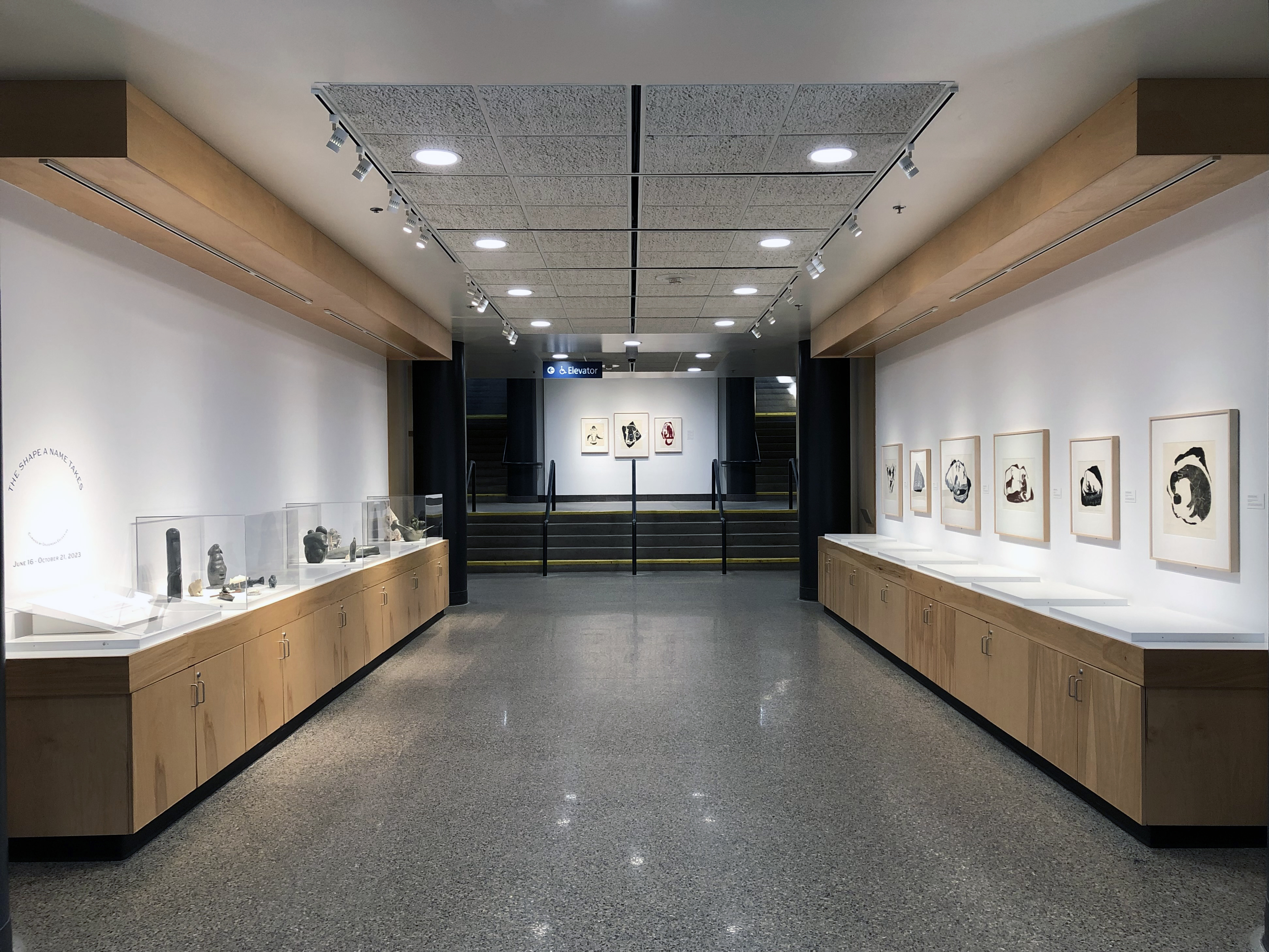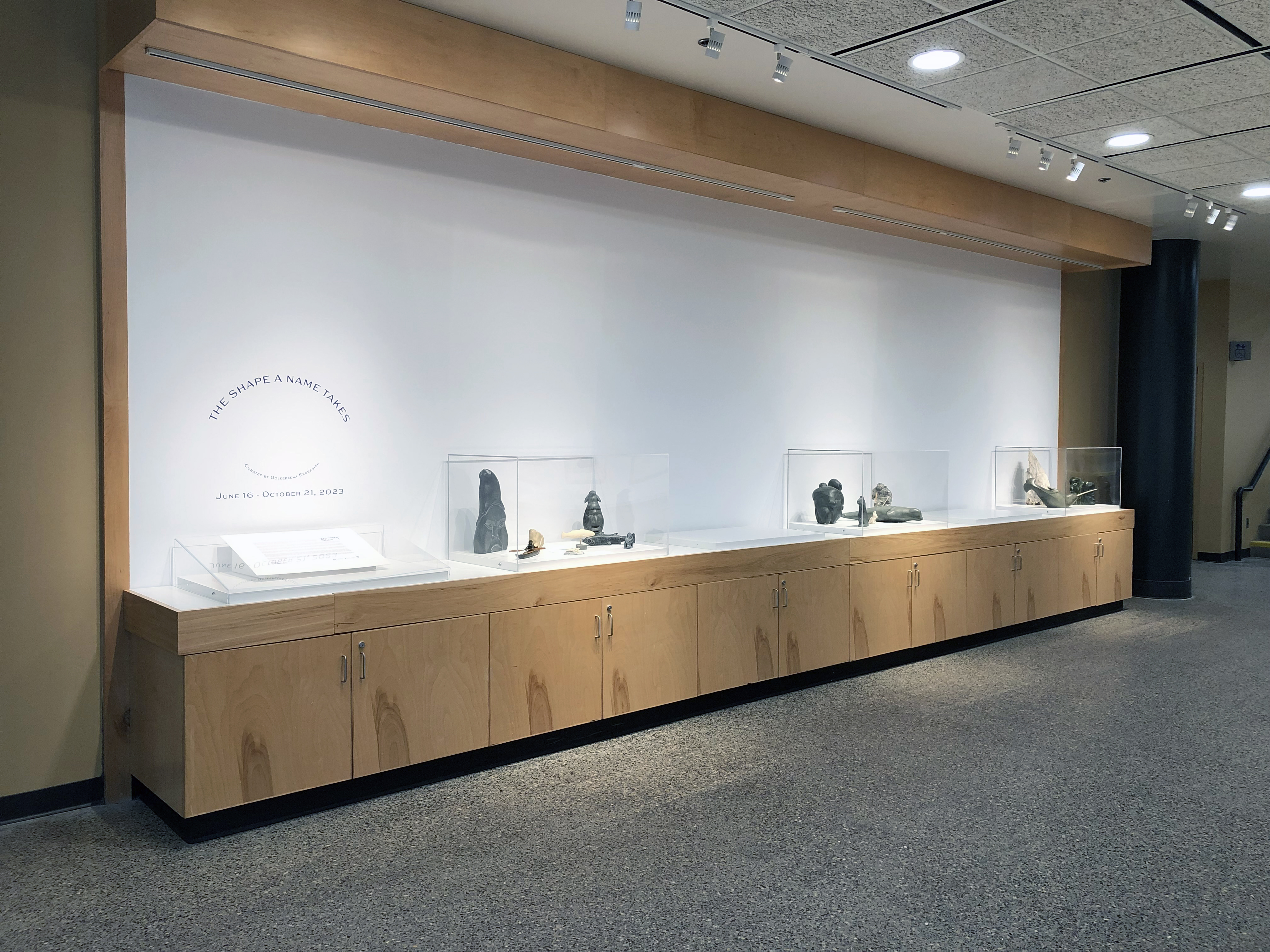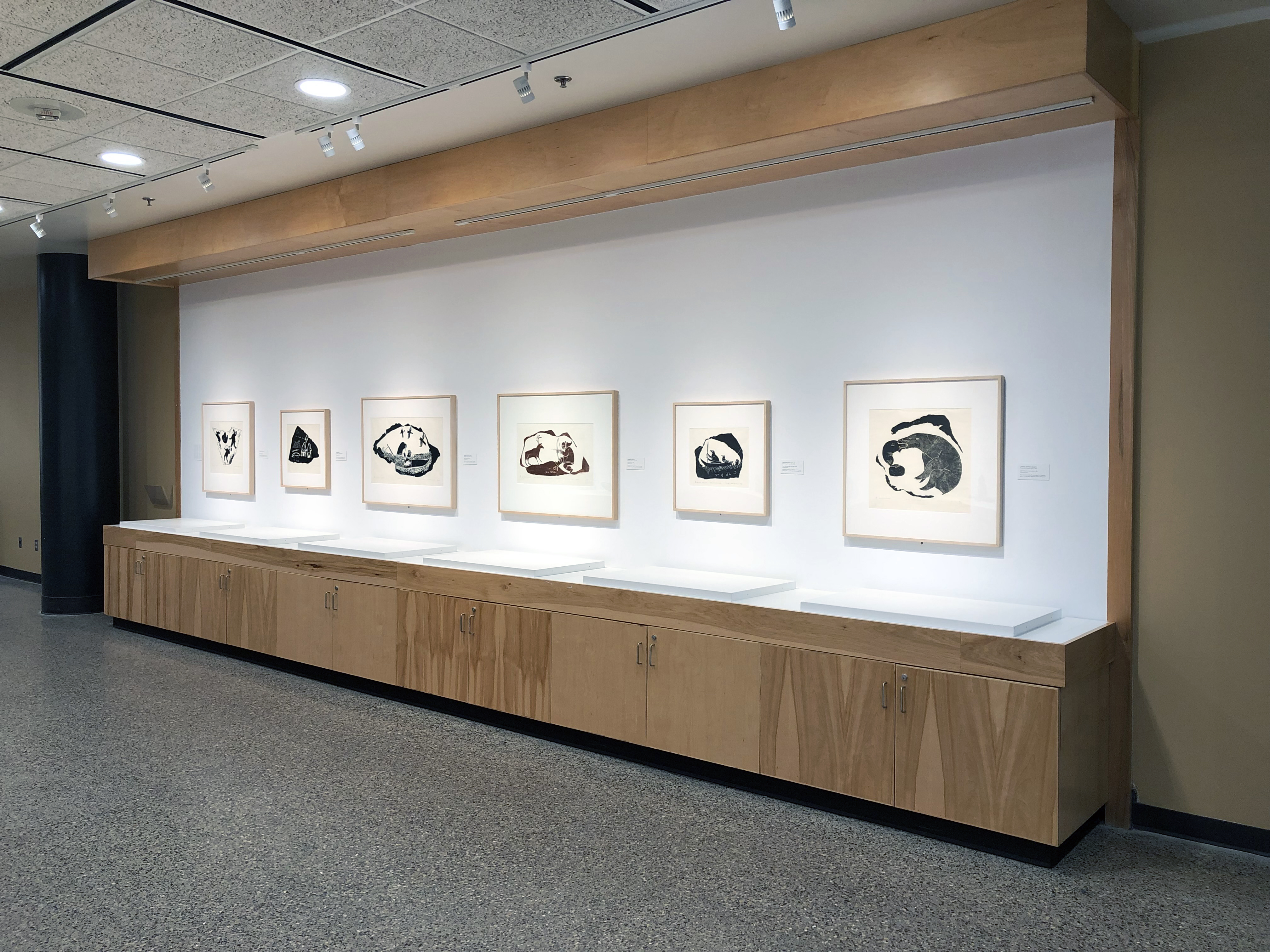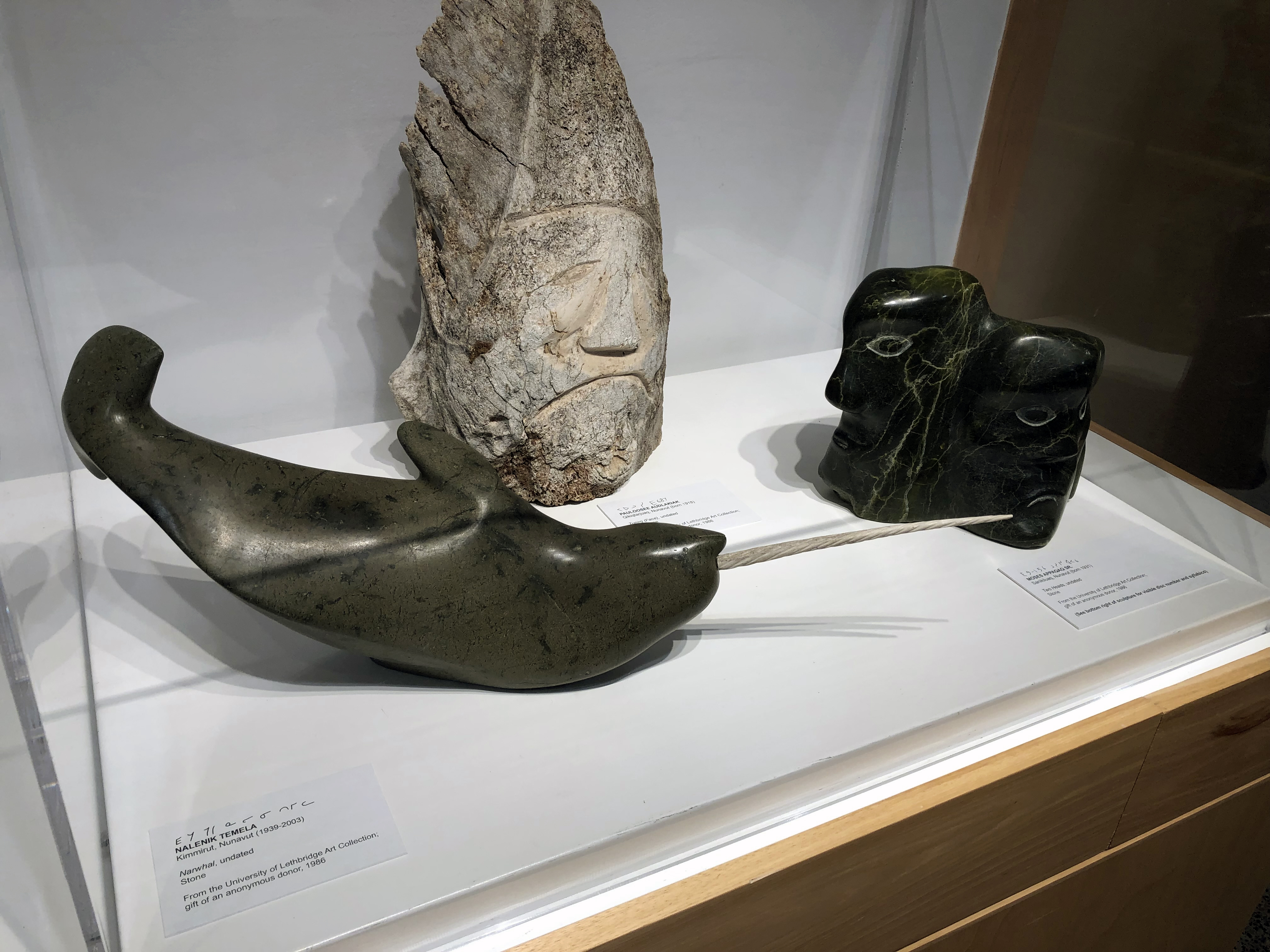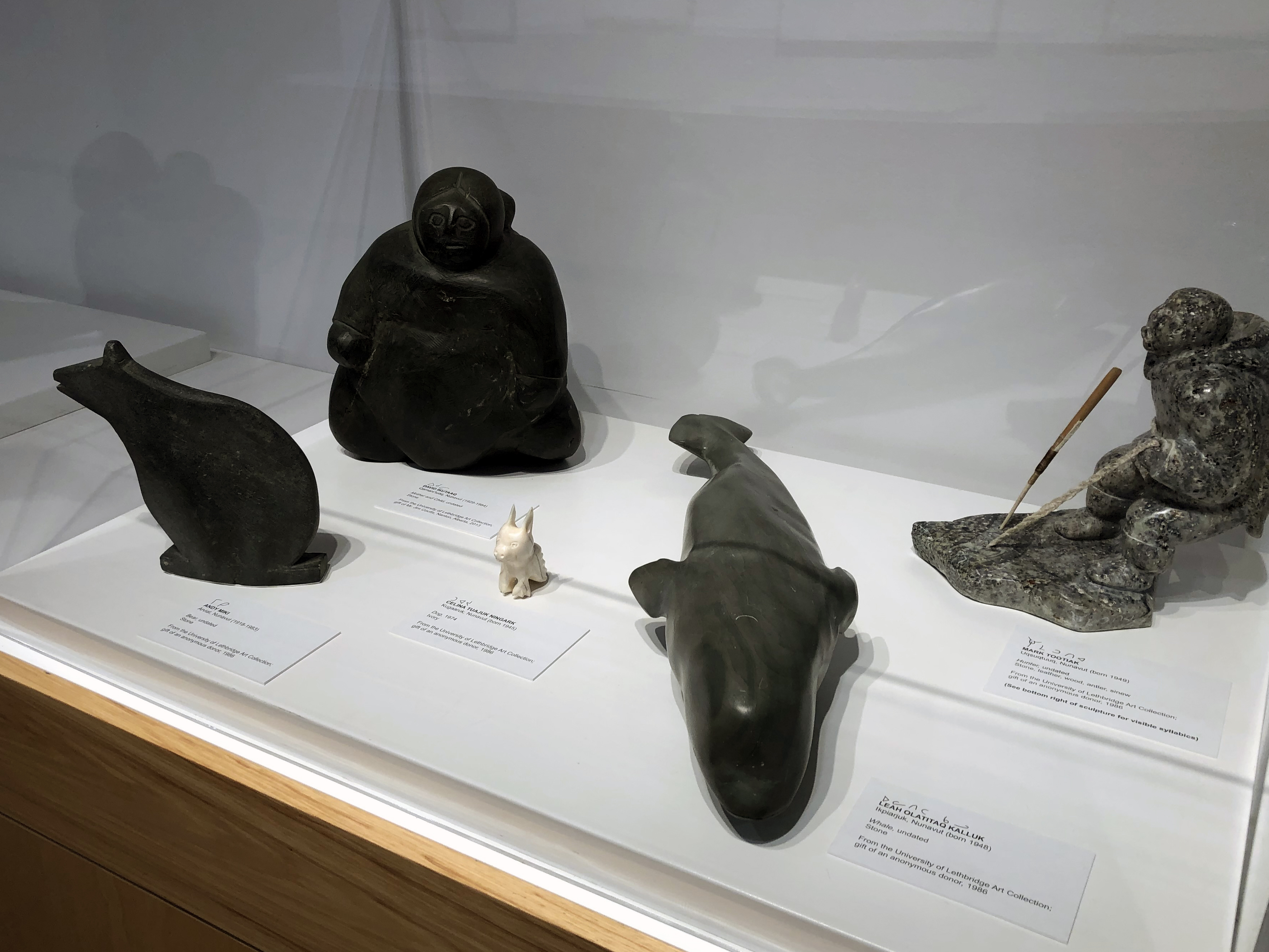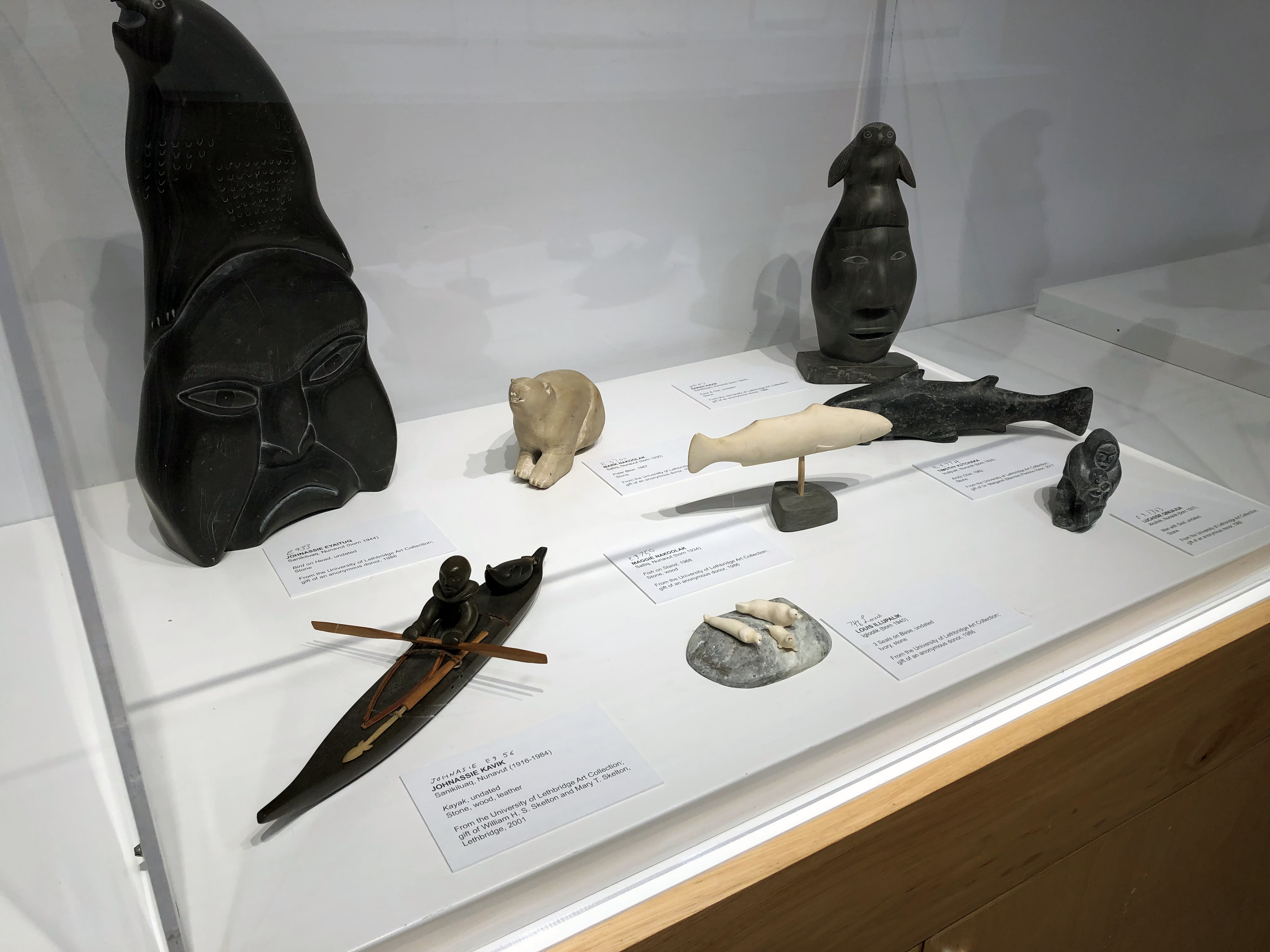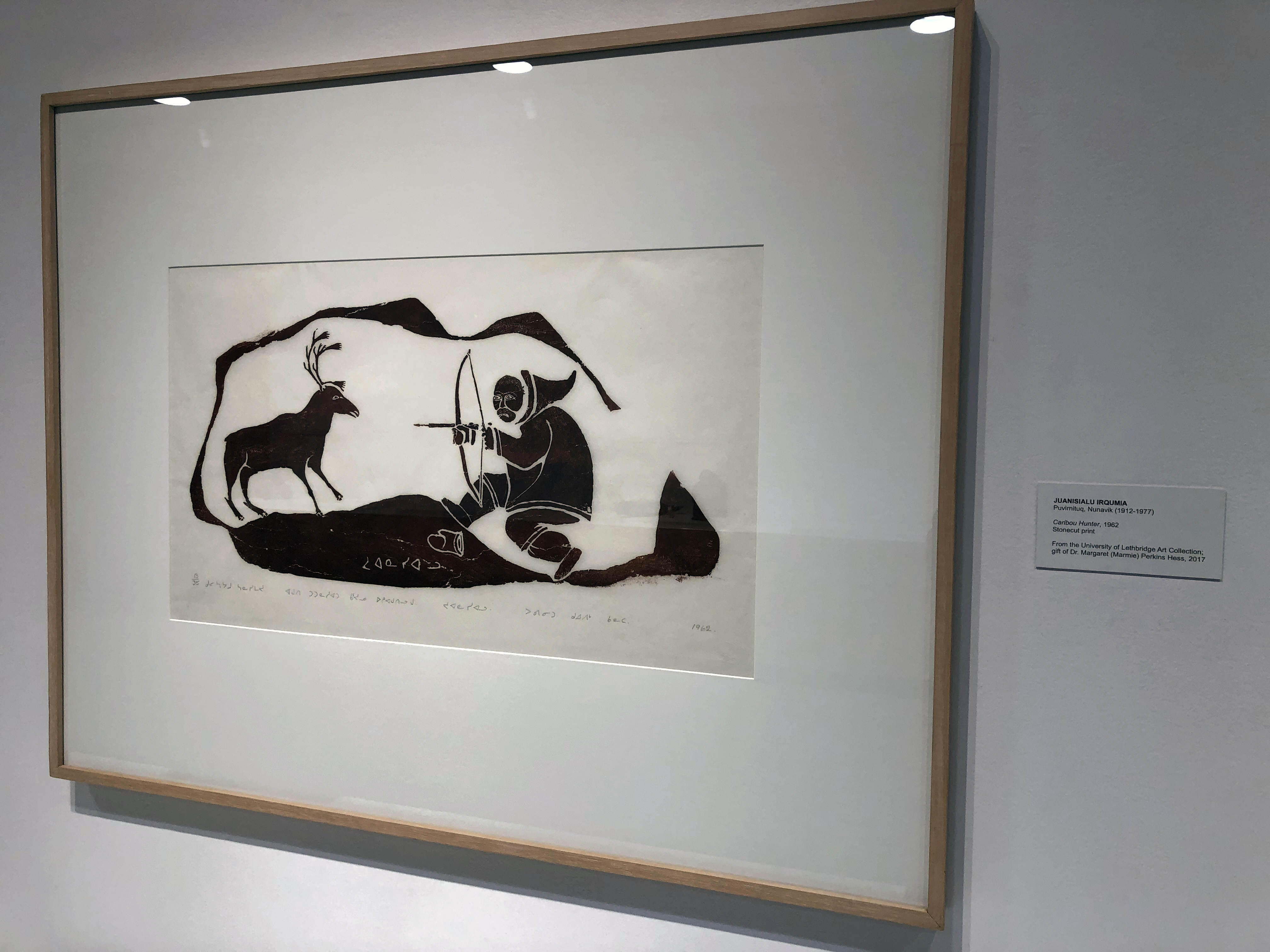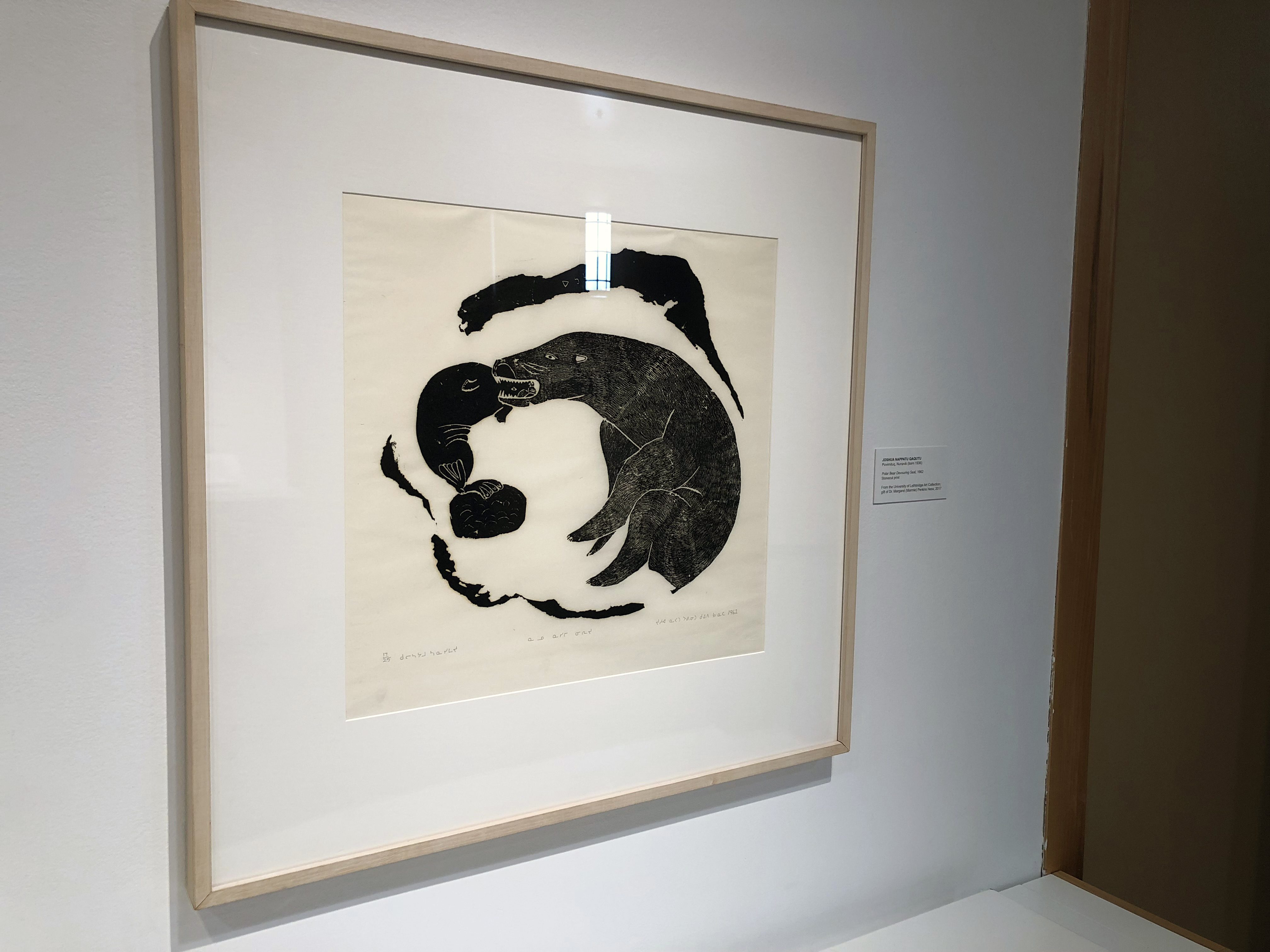Helen Christou Gallery
The Shape a Name Takes
June 16 – October 21, 2023
Curator: Ooleepeeka Eegeesiak
In 2022 and 2023, 38 Inuit artworks designated “unknown artist” in the University of Lethbridge collection were able to be identified through Inuktitut syllabics and disc numbers.
Curatorial Statement
This year, I undertook a project to identify the 124 anonymous Inuit artworks in the University of Lethbridge art collection. Tracing these names was a special experience, as an Inuk who has lived in Treaty 7, or southern Alberta, for much of my life. Growing up, my dad would mention his disc number but I didn’t quite understand what that meant until I got a bit older. There was always a syllabics chart on the wall in our house, and while I don’t speak the language, whenever relatives would call I would listen to Inuktitut being spoken and wish I could communicate in that way. I really connected with this project as my name is so out of place outside of Inuit Nunangat, having explained where my name comes from so often. I may find myself in the south, as do the artworks in this exhibition; and Inuit naming traditions may have been targeted through colonization, but we are still Inuk.
While I was only able to attribute 38 out of 124 artworks, each that was uncovered was an identity affirmed. Artwork with unknown origins or misnomers in collections are relatively common, and not particular to Inuit artworks. An obscurity may exist for various reasons— donors may not have provided or known the name of the artist, a miscommunication may have occurred prior to a donation to the collection, or the names signed on the artworks were not yet translated and recorded. The project to find the artist’s names involved physically checking each artwork, turning the carvings over to view the underside. Finding an engraving of a signature was thrilling, and in equal measure, not finding anything was a disappointment. The inscriptions that I used to identify the artists can be found at the top of the sculpture labels in this exhibition as they were written.
Most identifications of the artists were made through names signed in syllabics, or qaniujaaqpait, which is a system used to write Inuktitut that is different than the Latin alphabet. Some of the artists signed their artworks in qaniujaaqpait, which I could then translate into roman orthography. This process was valuable not only to increase the information on the art in the collection, but I was also able to practice reading and writing syllabics. Inuktitut was an oral language until colonization, and syllabics were initially brought into use by Christian missionaries in the Arctic but then widely adopted by Inuit. Missionaries also brought Christian names, and Inuit altered some of them, such as the names Johnassie, Pauloosee, Davidialuk, and Lucassie.
Disc numbers were also found on some sculptures. Disc numbers were individual numbers exclusively assigned to Inuit from the 1940s to the 1970s by the Canadian government, the justification for which was that non-Inuit administrators had difficulty pronouncing Inuit names, and that they did not conform to the Euro-Canadian use of patrilineal last names, using mononyms until after Project Surname in 1970. In the book Kinauvit: What’s Your Name? Norma Dunning explained that “[i]nstead of taking the time to learn how to say and spell an Inuk name by conversing with the Inuit themselves, the government of the day removed Inuit names and replaced them with a numbering system that amounted to an early form of digital surveillance.”[1]
Each Inuk received a small disc-shaped tag with a number, indicating the community and individual, which they were required to keep on their person. Disc numbers were used in daily interactions for government documents; while making purchases or trades; and in the Canadian legal, healthcare, and education systems. This system was imposed on Inuit without consent and eroded traditional naming practices. It was part of the broader attempts at totalizing colonial control over Inuit. It was emphasized to Inuit in receipt of these numbers that if they lost them or did not remember them, their access to services or resources would be denied. Dunning elaborated that “[w]ithout a disc number, Inuit Canadians were denied access to the same benefits that all other Canadians used daily.”[2] The disc numbers appeared on the surfaces of many of the sculptures in the collection, and sometimes was the only identifying information used by the artist, which is evidence of just how impactful this system was. I was able to match the numbers using online and print records that listed these artist’s names.
Our names are a large part of being Inuk. Inuit naming traditions have been interfered with but continue. An Inuk can have multiple names they are known by that are not on their birth certificate. An atiq, or name, and souls are interlinked. Sauniq, or namesake, is one central concept and practice. When a child is named after someone, they become that person. Family members that have passed and the next generations are connected in this way. These identities are woven into community and kinship. While names are only one facet of our identities, if taken away, who are you?
Ooleepeeka Eegeesiak
Curator
[1] Dunning, Norma, Kinauvit?: What’s Your Name? The Eskimo Disc System and a Daughter’s Search for Her Grandmother, (Douglas & McIntyre, 2022) 79.
[2] Dunning, Norma, Kinauvit?, 137.
Artists Identified (artists with * are included in the exhibition):
Piuliak Allasuaq
Davidialuk Alasua Amittu*
Noah Annanack
Moses Appaqaq Sr.*
Samuel Arnakallak
Pauloosee Audlakiak*
Johnassie Eyaituq*
Louis Illupalik*
Ikutaaq or Iquliq (syllabics signed on sculpture could indicate either name)*
David Nanuk Iqualuk
Juanisialu Irqumia*
Aisa Aviliaju Itukalla*
Leah Olatitaq Kalluk*
Jimmy Kattuk
Johnassie Kavik*
Sarah Kavik*
Simanuk Kilabuk
Timothy Kutchaka*
Victoria Mamnguqsualuk
Andy Miki*
Annie Mikpiga*
Maggie Nakoolak*
Mark Nakoolak*
Celina Tuajuk Ningark*
Ashevak Palituq
Ulayu Pingwartok
Regilee Piungituq
Joshua Nappatu Qaqutu*
Lucassie Qinuajua*
Timothy Quananaapik*
Leah Nuvalinga Qumaluk*
Egesiak Simonie
Nalenik Temela*
Shoo Tikivik
Mark Tootiak*
Kanayuk Tukalak*
Alasi Audla Tullaugak*
Arpik Johnny Tuniq

